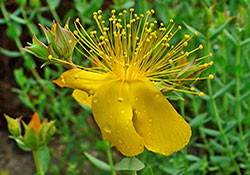Office of Research & Development |
 |

VA Research Currents archive
Posted November 20, 2013
Flowers may be among the most delicate creations in nature, but they have also developed powerful mechanisms to fend off harmful microbes and other environmental threats.

VA researchers are collaborating with scientists from Britain to study the anti-bacterial properties of Hypericum olympicum, commonly known as St. John's Wort. (Photo by H. Zell, via Wikimedia Commons)
So it is with the Hypericum olympicum, commonly known as St. John's Wort, a small Eurasian shrub adorned with distinct star-shaped yellow blossoms that is already used by many as an herbal remedy for depression. Researchers at the Detroit VA Medical Center, collaborating with scientists at the UCL School of Pharmacy in London, suspect extracts from the flower might be able to defeat methicillin-resistant strains of Staphylococcus aureus, or MRSA.
MRSA is resistant to many common antibiotics, and infections caused by this organism can be difficult to treat. The infections can quickly spread throughout the body and become potentially life-threatening. MRSA is particularly dangerous in hospitals and other medical facilities, where patients may have open wounds or weakened immune systems.
Hoping to find a new antibacterial, the researchers collected parts of the flower from the Royal Botanic Garden Kew in the United Kingdom and ground them into a powder. The powder was then isolated in a soxhlet apparatus, a device first used in labs more than 120 years ago that is still used by scientists today to filter out impurities.
The study involved bringing the resulting compound into contact with several different Staphylococcus strains, including antibiotic-resistant types, across a variety of testing conditions, to see how the bacteria reacted. Researchers found that the compound did in fact display antibacterial properties. Although the presence of blood tended to disrupt its effectiveness, researchers believe the compound could prove useful as a topical application to disrupt bacteria living on the skin, or inside the nasal passages, where MRSA tends to thrive.
Further research is required to better isolate the flower's antibacterial properties, but the study may suggest a novel way to tackle drug-resistant infections.
(International Journal of Antimicrobial Agents, online Sept. 16, 2013)